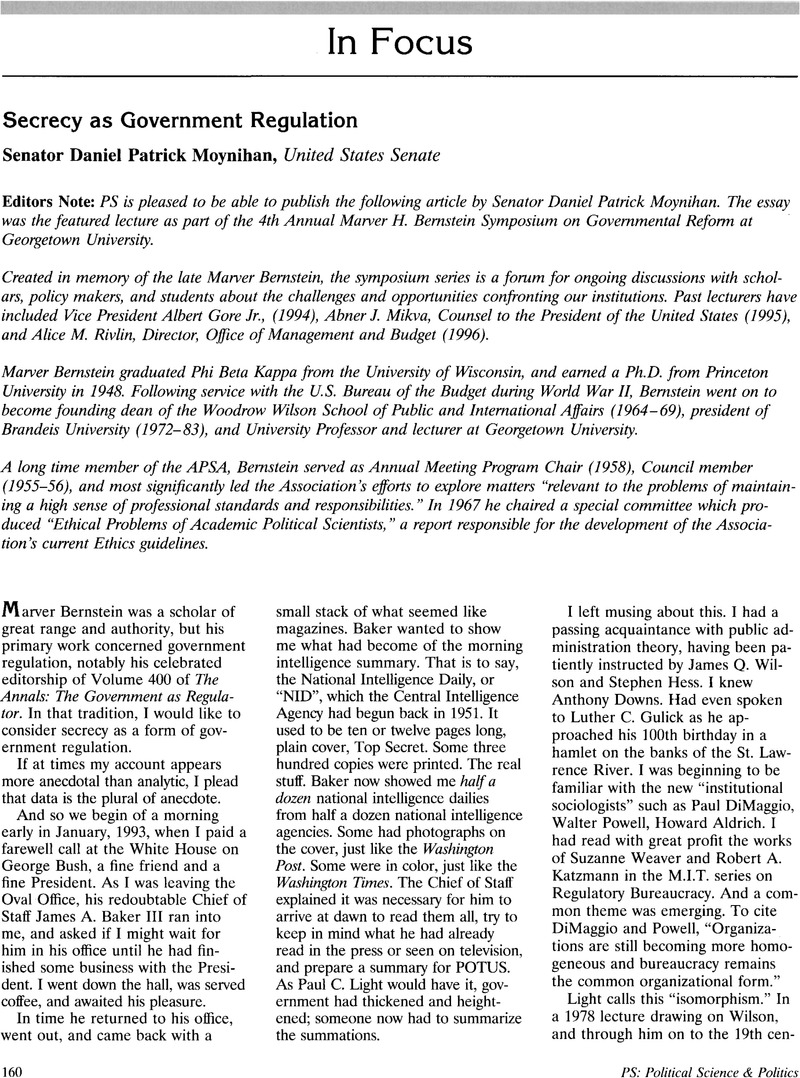Published online by Cambridge University Press: 02 September 2013

1. Chiniquy, Charles, Fifty Years in the Church of Rome (London: Protestant Literature Depository, 1886; reprint, Grand Rapids: Baker Book House, 1958), p. 512 Google Scholar.
2. Draper, Theodore, “Getting Irangate Straight,” New York Review of Books, October 8, 1987, p. 47 Google Scholar.
3. Weber, Max, Essays in Sociology, trans. and ed. Gerth, H. H. and Mills, C. Wright (New York: Oxford University Press, 1946), pp. 233–34Google Scholar. Wirtschaft and Gesellschaft (Economy and Society), 1922.
4. Wilson, James Q., The Investigators: Managing FBI and Narcotics Agents (New York: Basic Books, 1978), pp. 202–203 Google Scholar.
5. Here is Wilson's passage in full:
[Hoover] was strong enough to resist for many years FBI involvement in organized crime and civil rights cases, but when the time came, in his eyes, to change, he was also strong enough to make the organization change with him. At one time, Hoover asserted that “no single individual or coalition of racketeers dominates organized crime across the nation“—in short, the Mafia is a myth. Then a New York state police trooper in 1957 stumbled across the Apalachin meeting of dozens of top gangland figures from across the country and the Justice Department, first under President Eisenhower and then, on a larger scale, under President Kennedy, created an Organized Crime unit among its attorneys. After the FBI had eavesdropped on some gangland meetings and acquired a few highly placed informants, Hoover moved swiftly to ensure that each field office would give serious attention to organized crime by creating special squads for its investigation. Suddenly, the Mafia existed—or more accurately, “LCN” (La Cosa Nostra) existed.
It is easy to be amused by this switch, but one also has to be impressed by it. In retrospect, it seems clear that many of the things the FBI did that, when revealed, aroused public criticism represented the defects of the Bureau's organizational virtues. An organization strong enough to stamp out agent corruption and partisanship, to resist presidential directives regarding domestic counterintelligence, to insist that the civil liberties of suspects be protected long before the Supreme Court required it, and to investigate the Ku Klux Klan even when it had many powerful political allies was also strong enough to launch an investigation of domestic radicals without any guidelines, to serve the partisan interests of various presidents who wanted to know things about their political rivals, and to attempt to discredit groups that had broken no laws. Now that Hoover's successors have decided to put more authority in the hands of field administrators and allow for the development of different law enforcement priorities in different communities, the Bureau discovers that, though this change is slow and difficult, it is much easier to decentralize something that has first been centralized.
6. Powers, Richard Gid, Secrecy and Power: The Life of J. Edgar Hoover (New York: The Free Press, 1987), pp. 267–74Google Scholar.
7. “Albert Shanker, 68, Combative Leader Who Transformed Teachers' Union, Dies,” The New York Times, Monday, February 24, 1997, p. A22 Google Scholar.
8. Benson, Robert Louis and Warner, Michael, eds., VENONA: Soviet Espionage and the American Response, 1939–1957 (Washington, D.C.: National Security Agency, Central Intelligence Agency, 1996)Google Scholar.
9. Powers, , Secrecy and Power, p. 286 Google Scholar.
10. President Eisenhower may have learned on his own whilst still in the Army. This, however, is not clear, either.
11. Robinson, Donald L., “The Routinization of Crisis Government.” Yale Review 63 (Winter 1974), p. 161 Google Scholar.
12. U.S. Congress, Senate, Committee on Foreign Relations, Estimating the Size and Growth of the Soviet Economy: Hearing Before the Committee on Foreign Relations, 101st Cong., 2nd sess., July 16, 1990, p. 33 Google Scholar.
13. Shils, Edward A., The Torment of Secrecy, with an introduction by Moynihan, Daniel P. (Glencoe: The Free Press, 1956; reprint, Chicago: Ivan R. Dee, Inc., 1996), pp. 70–71 Google Scholar.
14. Novak, Robert D., “China's Savior,” Washington Post, February 24, 1997, p. A 19 Google Scholar.
15. Downs, Anthony, Inside Bureaucracy (Boston: Little, Brown, 1967), p. 19 CrossRefGoogle Scholar.
16. Weiner, Tim, “C.I.A. Severs Ties to 100 Foreign Agents,” New York Times, March 3, 1997, p A–12 Google Scholar.